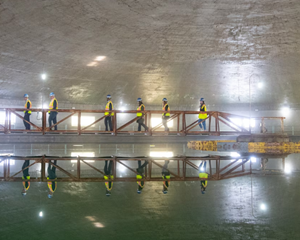Most U.S. residents don't need to worry about the safety of their tap water, but millions of Americans are still exposed to contaminants every year.
大部分美国居民都不需要担心家中自来水的水质安全与否,但每年还是有数百万美国人会暴露在污染物之中。
It can take a water crisis to highlight where drinking water infrastructure is failing.
或许要碰到饮用水危机,才能凸显供水基础设施之不足。
One of the most devastating water crises in recent memory was the lead contamination in Flint, Michigan's drinking water in 2014.
大家都还记忆犹新的严重用水危机之一,是2014年密歇根州弗林特的饮用水铅污染事件。
As of January 2023, nine years after the initial contamination, residents are still dealing with the effects.
但一直到2023年1月,距最初的污染事件都已经九年了,该地居民都还在面对该事件的影响。
And in 2022 year, a water crisis in Jackson, Mississippi left many of the city's 150,000 residents without potable water.
而在2022年,密西西比州杰克逊发生的一场用水危机,也导致该市约15万名居民无法获得安全的饮用水。
Here, drinking water experts from the EPA, academia, and advocacy groups weigh in on what you need to know about your tap.
在这篇文章中,来自美国国家环境保护局(EPA)、学术界和倡议团体的饮用水专家将分享你需要了解的自来水相关信息。
In the U.S., about 90 percent of people get their tap water from a public water system (PWS).
美国约有90%的人口是使用公共供水系统(PWS)提供的自来水。
Water from a lake, reservoir, river or aquifer is piped into a water treatment facility where chemicals are added to the water that bind to pollutants and are sifted out of the system.
来自湖泊、水库、河流或地下水层的水被输送到净水处理厂、并加入化学物质,当这些物质与污染物结合之后,就会被过滤排除。

Some facilities also use bacteria-killing UV light.
有些净水厂还会使用紫外线(UV)来杀菌。
Chemical disinfectants such as chlorine or chloramine are then added to the water to help kill any pathogens remaining in the water and any that might be lurking in your pipes when the water travels to your home.
之后,净水厂会在水中加入像是氯或氯胺之类的化学消毒剂,来消灭残留在水中以及输送过程中可能藏在管道内的病原体。
Byproducts result when water, itself a chemical, mixes with chemical disinfectants. But these aren't always easy to discern.
水本身就是一种化学物质,当水与化学消毒剂混合时,就会产生副产物。但这些副产物不见得能够被轻松辨别出来。
A new study recently isolated and defined chloronitroamide, a byproduct of of chloramine that has been present in tap water for years but difficult to identify from other byproducts.
最近的一项研究分离出并定义了一种来自氯胺的副产物--氯硝酰胺,这种物质多年来一直存在于自来水中,但由于和其他副产物混杂在一起,所以难以识别。
It's not known to be toxic, but the study illustrates how complicated monitoring tap water for millions of Americans can be.
目前还不清楚这东西是否有毒,但这项研究也突显出,要为数百万美国人监控自来水是一件多复杂的事。
Some water treatment facilities, from lack of funding or too little oversight, don't effectively clean their water.
有些水处理设施因为缺乏资金或监管不足,因此不能有效清洁用水。
In 2015, about 21 million people living in the U.S. were exposed to tap water that violated federal guidelines, according to a study published in 2018.
根据2018年发表的一项研究,在2015年,约有2100万美国人接触到的是不符合联邦指导方针的自来水。
Unsafe and therefore illegal levels of pathogens (bacteria and viruses), nitrates, arsenic, and harmful byproducts were the most common sources of violations, says Maura Allaire, study author and a water quality expert at the University of California, Irvine.
该研究的作者、加州大学尔湾分校的水质专家茉拉·阿莱尔表示,因为不安全而含量高到违法的病原体(细菌和病毒)、硝酸盐、砷和有害副产品,是最常见的违规来源。



